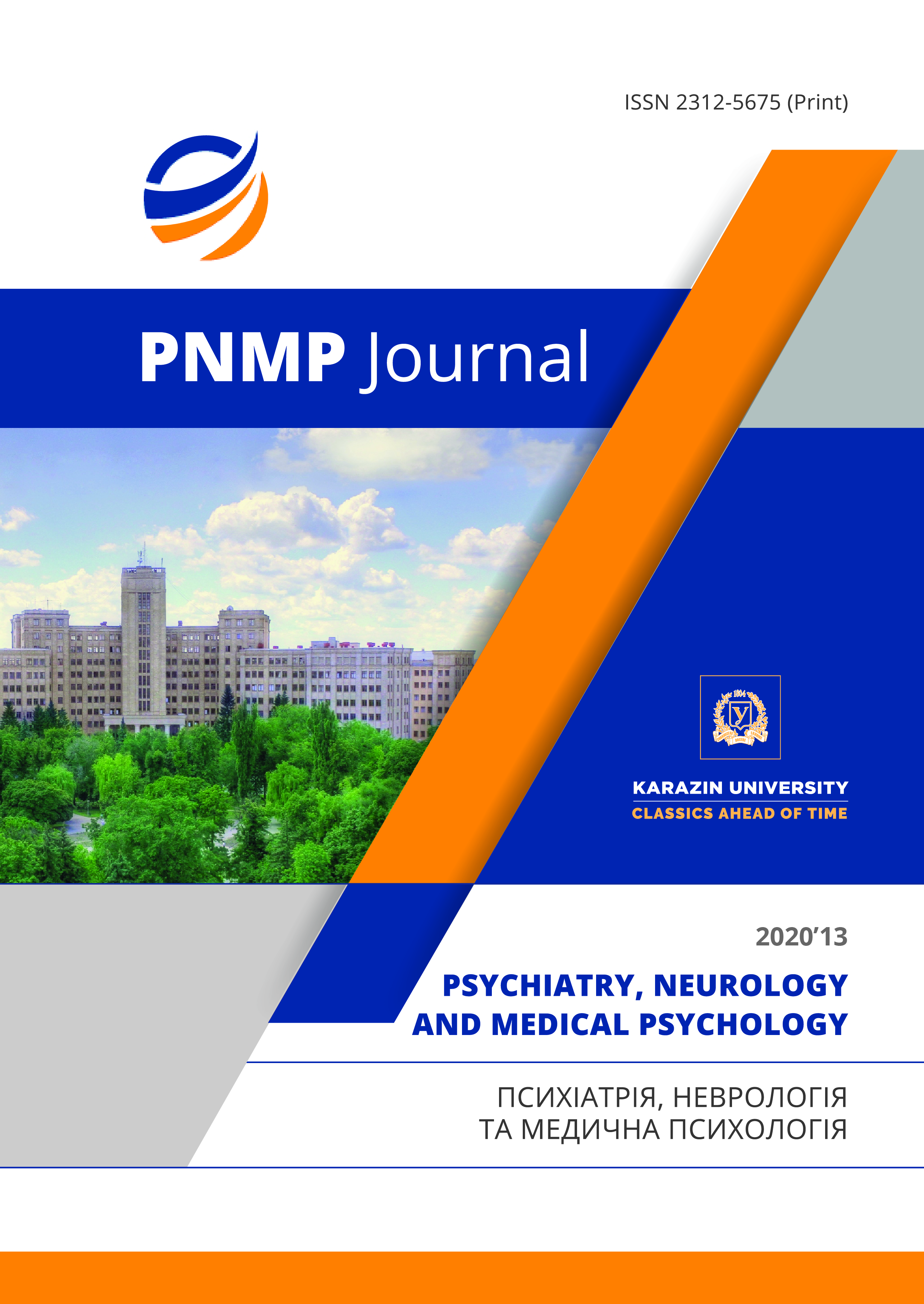Нейропластичність в ряду індукованих ефектів транскраніальної електростимуляції
Анотація
У даній статті відображені результати аналізу сучасних наукових даних щодо індукції нейропластичності за допомогою транскраніальної електростимуляції. Розглянуто три типи ефектів, що виникають при застосуванні транскраніальної електростимуляції: центральні, периферичні і змішані. До центральних ефектів віднесені аналгезія, стабілізація гемодинаміки, купірування больового синдрому. Периферичні ефекти включають в себе уповільнення зростання пухлин, модуляцію динаміки гострофазової відповіді при запаленні, прискорення загоєння шкірних ран, виразкових дефектів слизової оболонки шлунка, вогнищ некрозу при інфаркті міокарду. Зі змішаних ефектів представлені антистресовий, протисвербіжний, антітоксичний ефекти. В основі усіх перерахованих вище ефектів лежить виділення бета-ендорфінів. Потенціювання ефектів транскраніальної електростимуляції викликається інгібіторами енкефалінази, прекурсорами 5-НТ, інгібіторами моноаміноксидази та триптофанпіролази. Виділено особливості терапевтичних ефектів транскраніальної електростимуляції: вони мають гомеостатичний характер і проявляються як комплексно, так і системно. Розглянуто вплив на нейропластичність методом транскраніальної стимуляції постійним струмом (tDCS). tDCS представлена як модулятор глобальної нейронної активності. Показано, що tDCS призводить до активації нейронів і астроцитів через нейроваскулярні сполучення, безпосередньо впливає на клітини судинного ендотелію, сприяє збільшенню швидкості кровотоку в капілярах. Показано, що транскраніальна електростимуляція надає коригуючий вплив на клінічні електрофізіологічні показники у хворих з нейрогенною дисфункцією сечового міхура і з нічним енурезом, має стимулюючий вплив на гліальні клітини, різнопланово змінює нейрохімічний статус мозку, модифікує синаптичне мікрооточення, регулює різні нейротрансмітери, підвищує секрецію BDNF. Дослідження показують, що tDCS призводило до значного зниження глутамату і глутаміну в передній поясній звивині, до тенденції до зниження глутамату і глютаміну в таламусі і тенденції до збільшення ГАМК в передній частині острівця. Таким чином, транскраніальна електрична стимуляція є методом, здатним забезпечувати довготривалі терапевтичні ефекти стимуляції і впливати на процеси нейропластичності.
Завантаження
Посилання
Vöröslakos M., Takeuchi Y., Brinyiczki K. [et al.]. Direct effects of transcranial electric stimulation on brain circuitsinrats and humans. Nature Communications. 2018, no. 9(1), p.483. DOI: 10.1038/s41467-018-02928-3
Bakulin I.S., Pojdasheva A.G., Pavlov N.A. [et al.]. Transcranial electrical stimulation to improve hand function in stroke. Advances in physiological sciences. 2019, np. 50(1), pp.90-104. [in Russ.] DOI: 10.1134/S030117981901003X
Rajgorodskij Yu.M., Sharkov S.M., Urnyaeva S.I. [et al.]. Transcranial electrical stimulation in the treatment of children with enuresis. Physiotherapy, valeneology and rehabilitation. 2014, no.4, pp.32-36. [in Russ.]
Mohammadi A. Induction of Neuroplasticity by Transcranial Direct Current Stimulation. Journal of Biomedical Physics and Engineering. 2016, no. 6(4), pp. 205–208.
Edwards D., Cortes M., Datta A. [et al.] Physiological and modeling evidence for focal transcranial electrical brain stimulation in humans: a basis for high-definition tDCS. NeuroImage. 2013, no. 74, pp. 266-275. DOI: 10.1016/j.neuroimage.2013.01.042
Savchenko A.B. Central analgesic and peripheral effects of transcranial electrical stimulation. Doct. Diss. Saint-Petersburg. 1994, 22 p. [in Russ.]
Andreeva I.N., Akishina I.V. Transcranial electrical stimulation. Astrakhan medical journal. 2012, no. 1, pp .22-27. [in Russ.]
Kolosova L.I., Lebedev V.P., Akoev G.N. [et al.]. Electrophysiological study of the effect of transcranial electrical stimulation on the effect of transcranial electrical stimulation on the functional recovery of the damaged sciatic nerve in the rat. Primary Sensory Neurone. 1997, no. 2(3), pp.177–183.
Rogova N.V., Petrov V.I. The effectiveness of transcranial electrical stimulation of endorphinergic brain structures in the correction of carbohydrate metabolism disorders in patients with type 2 diabetes. Non-drug medicine. 2009, no. 1, pp.54–59. [in Russ.]
Zyuzina N.A., Eliseeva L.N., Kade A.H. Improving the effectiveness of antihypertensive therapy using transcranial electrotherapy. Transcranial electrical stimulation: experimental clinical studies. SPb., Tsentr TES. 2009, pp. 237–243. [in Russ.]
Levtov V.A., Shuvaeva V.N. The effect of transcranial electroanalgesia on the rheological properties of blood. Transcranial electrical stimulation: experimental clinical studies. SPb., 2005, vol.2, pp.196–197. [in Russ.]
Kustarov V.N., Lebedev V.P., Sedneva S.A. The experience of using transcranial electrical stimulation in the treatment of premenstrual syndrome. Journal of Obstetrics and Women's Diseases. 2002, vol. LI(1), pp.61-63. [in Russ.]
Popova S.S., Gogua M.S., Alieva N.V. Comparative analysis of the possibilities of transcranial electrical stimulation and drug therapy in the treatment of the threat of abortion. Bulletin of RUDN, series Medical. 2009, no. 6, pp.310–316. [in Russ.]
Kade A.H., Lebedev V.P., Parahonskij A.P., Rubcovenko A.V. Immunomodulating effects of the synthetic analogue of enkephalins and transcranial electrical stimulation of the release of endogenous opioid peptides. Advances in Physiological Sciences. 1994, vol.25, no. 3, p. 24. [in Russ.]
Myagkov I.N. Nonspecific resistance in transcranial electrical stimulation. Omsk Scientific Herald. 2006, no. 7(43), pp.169-170. [in Russ.]
Lebedev V.P., Sergienko V.I. Development and justification of the therapeutic use of transcranial electrical stimulation of the brain's defense mechanisms using the principles of evidence-based medicine (results of twenty years of research). Transcranial electrical stimulation: experimental clinical studies. SPb., 2005, vol.2, pp. 11–69. [in Russ.]
Reed Т., Kadosh Roi Cohen. Transcranial electrical stimulation (tES) mechanisms and its effects on cortical excitability and connectivity. Journal of Inherited Metabolic Disease. 2018, no. 41(6), pp. 1123–1130. DOI: 10.1007/s10545-018-0181-4
Nitsche M.A., Cohen L.G., Wassermann E.M. [et al.]. Transcranial direct current stimulation: State of the art 2008. Brain Stimulation. 2008, no. 1(3), pp. 206-223. DOI: 10.1016/j.brs.2008.06.004
Monai H., Ohkura M., Tanaka M. [et al.]. Calcium imaging reveals glial involvement in transcranial direct current stimulationinduced plasticity in mouse brain. Nature Communications. 2016, vol.7, pp. 1-10. DOI: 10.1016/j.brs.2008.06.004
Wachter D., Wrede A., Schulz-Schaeffer W. [et al.]. Transcranial direct current stimulation induces polarity-specifi c changes of cortical blood perfusion in the rat. Experimental Neurology. 2011, vol. 227(2), pp. 322-327. DOI: 10.1016/j.expneurol.2010.12.005
Bragina O.A., Semyachkina-Glushkovskaya O.B., Bragin D.E. Anodic transcranial stimulation with direct current increases cerebral blood flow, tissue oxygenation and reduces neurological disorders in mice in normal and late post-traumatic period of traumatic brain injury. News of the Saratov University. New episode. Series Chemistry. Biology. Ecology. 2018, vol. 18(3), pp. 354-360. [in Russ.] DOI: 10.18500/1816-9775-2018-18-3-354-360
Ruohonen J., Karhu J. tDCS possibly stimulates glial cells. Clinical Neurophysiology. 2012, no. 123(10), pp. 2006-2009. DOI: 10.1016/j.clinph.2012.02.082
Yavari F., Nitsche M.A., Ekhtiari H. Transcranial Electric Stimulation for Precision Medicine: A Spatiomechanistic Framework. Frontiers in Human Neuroscience. 2017, vol.11, p. 159. DOI: 10.3389/fnhum.2017.00159
Medeiros L.F., de Souza I.C., Vidor L.P. [et al.]. Neurobiological effects of transcranial direct current stimulation: a review. Frontiers of Psychiatry. 2012, no. 3, p. 110. DOI: 10.3389/fpsyt.2012.00110
Brunoni A.R., Nitsche M.A., Bolognini N. [et al.]. Clinical research with transcranial direct current stimulation (tDCS): challenges and future directions. Brain Stimulation. 2012, no. 5, pp. 175-195. DOI: 10.1016/j.brs.2011.03.002
Stagg C.J., Bachtiar V., Johansen-Berg H. The role of GABA in human motor learning. Current Biology. 2011, no. 21(6), pp. 480-484. DOI: 10.1016/j.cub.2011.01.069
Fritsch B., Reis J., Martinowich K. [et al.]. Direct current stimulation promotes BDNF-dependent synaptic plasticity: potential implications for motor learning. Neuron. 2010, no. 66(2), pp. 198-204. DOI: 10.1016/j.neuron.2010.03.035.
Hunter M.A., Coffman B.A., Gasparovic C. [et al.]. Baseline effects of transcranial direct current stimulation on glutamatergic neurotransmission and large-scale network connectivity. Brain Research. 2015, no. 1594, pp. 92-107. DOI: 10.1016/j.brainres.2014.09.066
Rango M., Cogiamanian F., Marceglia S. [et al.]. Myoinositol content in the human brain is modified by transcranial direct current stimulation in a matter of minutes: a 1H-MRS study. Magnetic Resonance in Medicine. 2008, no. 60, pp. 782-789. DOI: 10.1002/mrm.21709
Clark V. P., Coffman B. A., Trumbo M. C. [et al.]. Transcranial direct current stimulation (tDCS) produces localized and specific alterations in neurochemistry: a1H magnetic resonance spectroscopy study. Neuroscience Letters. 2011, no. 500(1), pp.67–71. DOI: 10.1016/j.neulet.2011.05.244
Kim S., Stephenson M.C., Morris P.G. tDCS-induced alterations in GABA concentration within primary motor cortex predict motor learning and motor memory: а7Т magnetic resonance spectroscopy study. Neuroimage. 2014, no. 99, pp. 237-243. DOI: 10.1016/j.neuroimage.2014.05.070
Fregni F., Orsati F., Pedrosa W. [et al.]. Transcranial direct current stimulation of the prefrontal cortex modulates the desire for specific foods. Appetite. 2008, no. 51(1), pp. 34-41. DOI: 10.1016/j.appet.2007.09.016
Foerster B.R., Nascimento T.D., DeBoer M. [et al.]. Excitatory and inhibitory brain metabolites as targets and predictors of effective motor cortex tDCS therapy in fibromyalgia. Arthritis & rheumatology.2015, no. 67(2), pp. 576-581. DOI: 10.1002/art.38945
DosSantos M.F., Martikainen I.K., Nascimento T.D. Building up analgesia in humans via the endogenous μ-opioid system by combining placebo and active tDCS: a preliminary report. PLOS ONE. 2014, no. 9(7). e102350. DOI: 10.1371/journal.pone.0102350
Yoon E.J., Kim Y.K., Kim H.-R. [et al.]. Transcranial direct current stimulation to lessen neuropathic pain after spinal cord injury: a mechanistic PET study. Neurorehabilitation and Neural Repair. 2014, no. 28(3), pp. 250-259. DOI: 10.1177/1545968313507632
Brietzke A.P., Rozisky J.R., Dussan-Sarria J.A. [et al.]. Neuroplastic effects of transcranial direct current stimulation on painful symptoms reduction in chronic Hepatitis C: a phase II randomized, double blind, sham controlled trial. Frontiers in Neuroscience. 2015, no. 9, pp. 498. DOI: 10.3389/fnins.2015.00498




